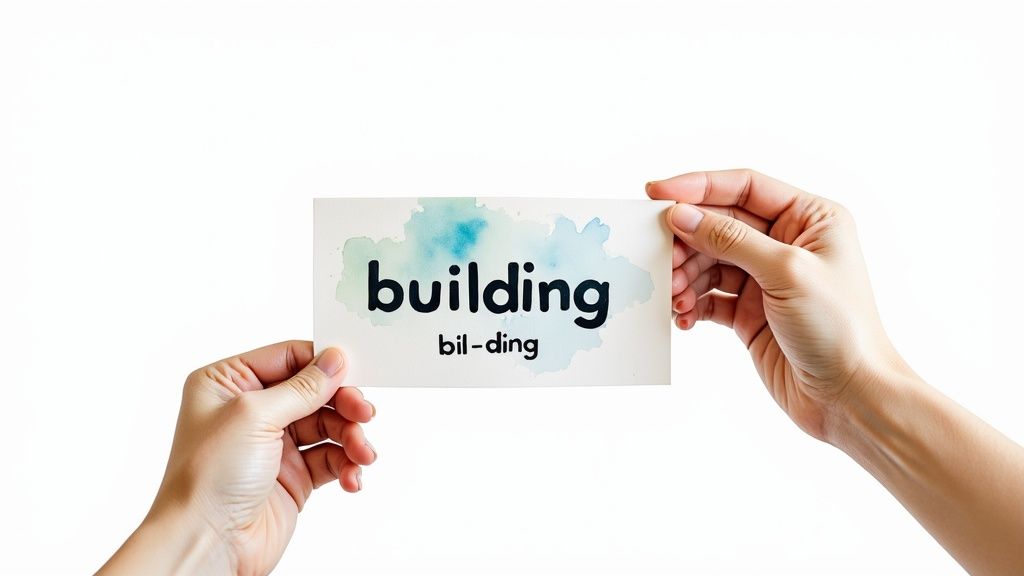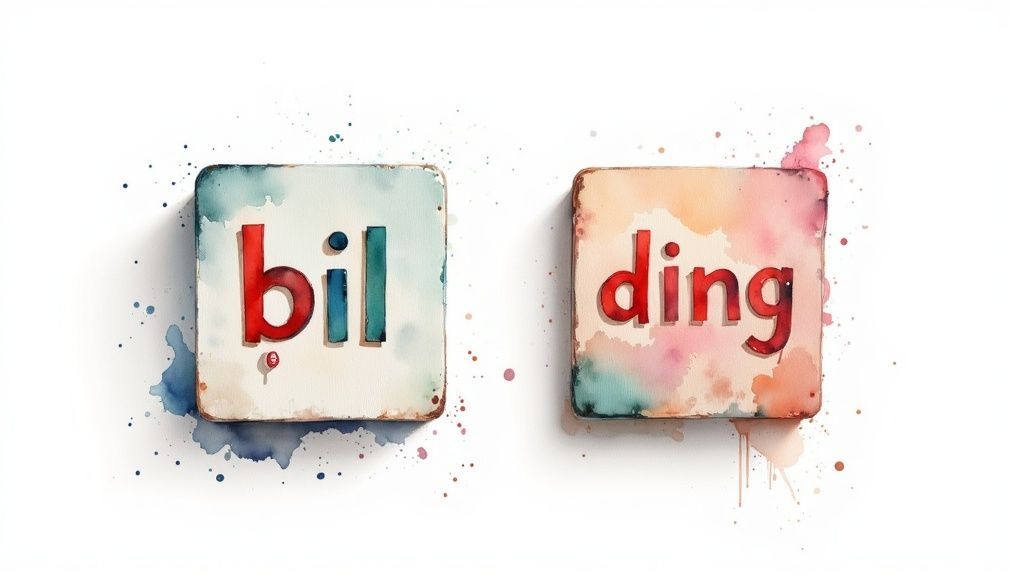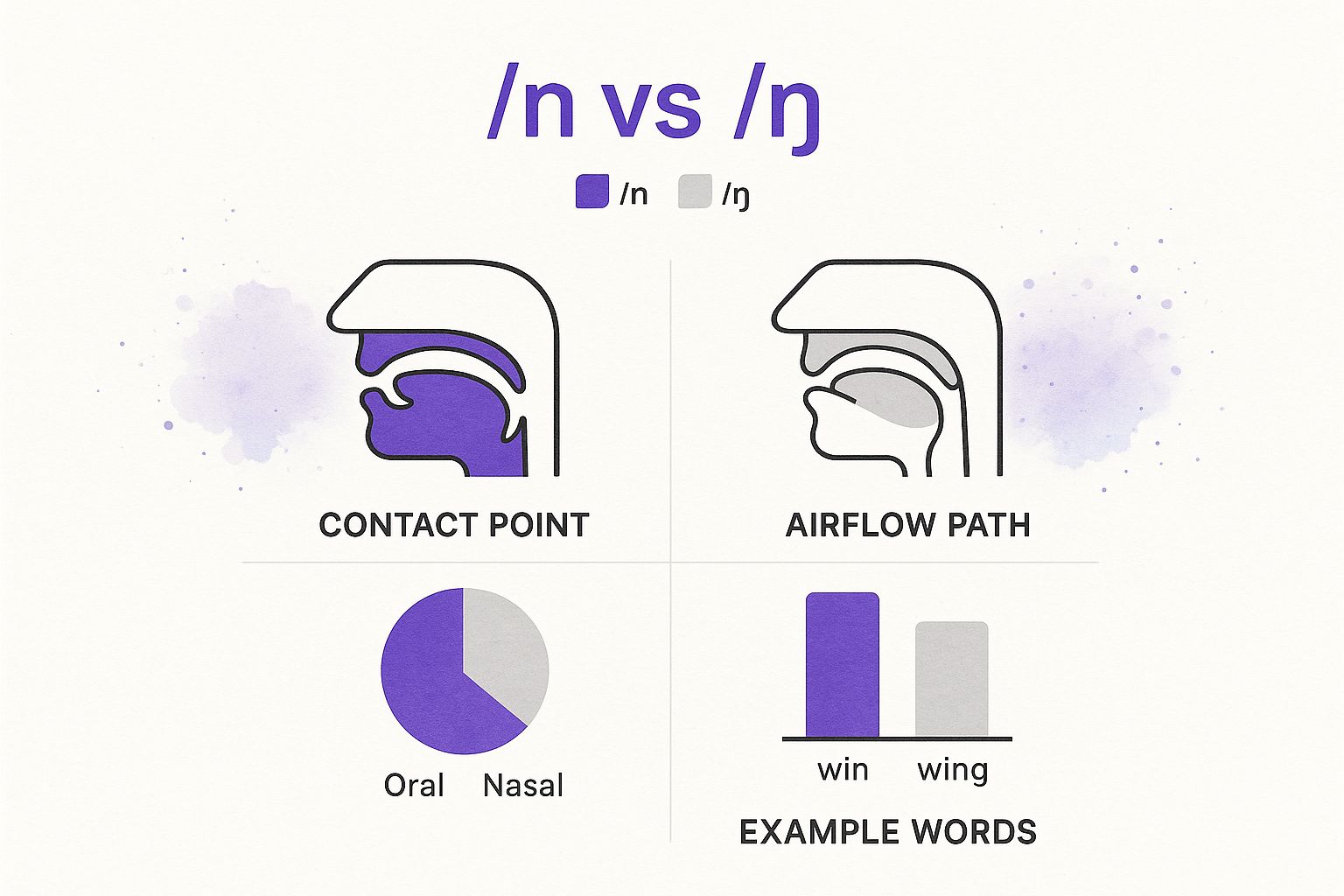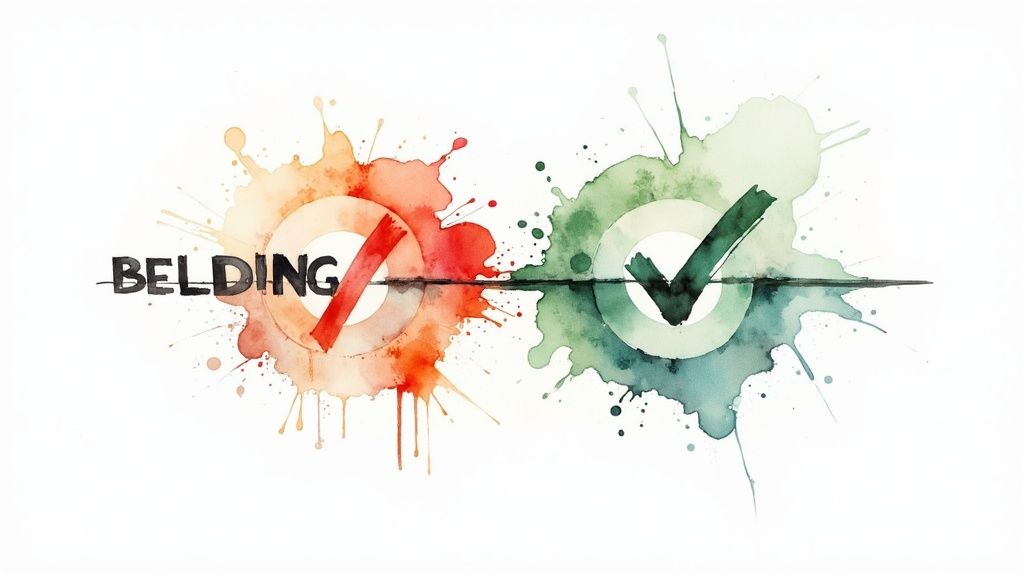How to Pronounce Building Like a Native Speaker
Struggling with how to pronounce building? Our guide breaks down the sounds, common mistakes, and mouth positioning to help you speak with confidence.


Let's get right to it and solve the 'building' pronunciation puzzle. The biggest secret? That 'u' is completely silent. Just ignore it. The word is pronounced simply as 'bil-ding'. I've seen so many English learners get tripped up by the spelling, but trust me, the sound is much more straightforward once you know this trick.

Breaking Down the Sound of 'Building'
Nailing the pronunciation of "building" is one of those small tweaks that instantly makes your English sound more natural. The main hurdle is that the spelling is a bit deceptive. Once you completely ignore the 'u', you’re already halfway there.
The word really just breaks down into two simple syllables: "bil" and "ding."
- The first part, "bil": This sounds exactly like the name "Bill." It uses that short /ɪ/ vowel sound you hear in words like "sit" or "ship."
- The second part, "ding": This follows with a crisp /d/ sound and finishes with that nasal /ŋ/ sound, just like in the word "sing."
The good news is that this pronunciation is remarkably consistent. The standard phonetic transcription, **/ˈbɪl.dɪŋ//, holds true for both UK and US English, which definitely simplifies things. If you'd like to dive deeper, you can explore detailed pronunciation guides on resources like the Cambridge Dictionary.
To make this even clearer, let's map out the sounds syllable by syllable.
Phonetic Breakdown for 'Building' (/ˈbɪl.dɪŋ/)
This table gives a quick summary of the sounds in 'building' with some easy-to-understand examples to help you lock it in.
| Syllable | Phonetic Sound | Example Word |
|---|---|---|
| First: bil | /b/ | bat |
| /ɪ/ | sit | |
| /l/ | leg | |
| Second: ding | /d/ | dog |
| /ɪ/ | sit | |
| /ŋ/ | sing |
As you can see, when you break it down like this, there are no real surprises. The six distinct sounds from /b/ to /ŋ/ flow together smoothly.
A key takeaway from my experience is to focus on the sounds, not the letters on the page. You need to hear the word in your mind, not just see it. This simple mental shift is your best tool for mastering tricky English words.
Breaking Down the Syllables: Bil and Ding
The easiest way to get the hang of pronouncing "building" is to split it into its two simple parts: "bil" and "ding". When you tackle each sound one at a time, the word becomes much less of a mouthful.

Getting the First Syllable "Bil" Right
Let's start with "bil". This part is pretty straightforward. You begin with a sharp /b/ sound by pressing your lips together and then releasing a small burst of air.
Right after that, you move into the short vowel sound /ɪ/. This is the same quick vowel you find in words like "sit" or "is." A common mistake is to drag this out into an "ee" sound, like in "seat," so keep it short and clipped.
Finally, you'll finish with a light /l/. Just let the tip of your tongue tap the ridge right behind your upper front teeth. If you can say the name "Bill," you're already pronouncing this syllable perfectly.
Mastering the Final Syllable "Ding"
Now for the second half: "ding." The tricky part for many English learners is the final /ŋ/ sound—that classic "ng" sound at the end. It's really common for people to accidentally swap it with a simple /n/ sound, which changes the word's pronunciation.
The secret is all in your tongue placement. For the /n/ sound (like in "win"), the tip of your tongue presses behind your teeth. But for the /ŋ/ sound (like in "wing"), it's the back of your tongue that rises to press against the soft palate.
Feel that difference? Isolating this movement is the key to nailing the sound. Sharpening your ear for these subtle phonetic differences is also a huge help, which is where exercises to improve your English listening skills can really pay off.
Getting the Feel: Your Mouth and Tongue Position
Think of pronunciation as a physical skill, almost like a sport for your mouth. To really nail the pronunciation of building, you need to get the mechanics right. It's all about the precise, controlled movements of your lips and tongue. Let's walk through how to feel the word as you say it.
The word kicks off with the /b/ sound. This one's pretty straightforward. Just press your lips together, let a little air build up behind them, and then release. You should feel a tiny, soft pop as they part.
From there, we move right into the /l/ sound. Your lips will part slightly. The real work here is done by your tongue—press the very tip of it against the alveolar ridge. That's the bumpy part of the roof of your mouth just behind your top front teeth.
Tackling the Tricky "ng" Sound
For many learners, the real challenge is that final /ŋ/ sound. This is what separates "din" from "ding" and it all happens at the back of your mouth. To get it right, you need to lift the back of your tongue so it presses firmly against your soft palate (the fleshy, soft part at the very back of the roof of your mouth).
This infographic is a great visual for comparing the tongue position for the /n/ sound versus the final /ŋ/ sound in building.

Notice that key difference? It’s all about where your tongue makes contact. Tip of the tongue for /n/, back of the tongue for /ŋ/. Getting that placement down is everything.
Pro Tip: Use vibration as a self-check. Gently place your fingers on the sides of your nose. If you say "win," you'll feel a slight buzz. Now, when you correctly say "wing" or the end of "building," that nasal vibration should feel much stronger and more resonant.
This kind of physical feedback is fantastic for building muscle memory. With a bit of practice, these movements will start to feel second nature. This physical awareness is a huge part of what it takes to learn an English accent that sounds and feels natural.
Common Pronunciation Mistakes to Avoid
Knowing the common pitfalls when learning how to pronounce building gives you a major advantage. Even experienced speakers can fall into old habits, but catching these mistakes is the first step toward clearer, more confident speech. Let's break down the most frequent errors and, more importantly, how to fix them.

The number one trip-up, without a doubt, is trying to pronounce the silent 'u'. Many learners see the letters "u-i-l" and their brain automatically tries to voice the 'u'. This leads to sounds like "byool-ding" or even "bweel-ding."
Just remember: that 'u' is completely invisible to your ears. The first syllable is simply "bil," just like the name Bill.
Vowel and Consonant Mix-Ups
Another common issue is with the vowel sound in that first syllable. It’s easy to accidentally stretch the short /ɪ/ sound into a long "ee" sound, which makes the word come out as "beelding." The trick is to keep that vowel short and sharp, exactly like the vowel in words like "sit" or "is."
Finally, that tricky ending can get you. Confusing the /ŋ/ sound (the 'ng' in "sing") with a simple /n/ is a very common habit. This small change makes the end of the word sound like "din" instead of "ding."
The difference is subtle but significant. Saying "build-in" instead of "build-ing" is a clear sign to native speakers that you might be struggling with the word. Focusing on that final nasal sound makes a world of difference.
Here’s a quick look at these common errors side-by-side so you can spot them in your own speech.
Fixing Common 'Building' Pronunciation Errors
| Common Mistake | Correct Pronunciation | Correction Tip |
|---|---|---|
| Voicing the silent 'u' ("byool-ding") | /ˈbɪl.dɪŋ/ (bil-ding) | Treat the first syllable like the name "Bill." The 'u' is silent. |
| Lengthening the vowel ("beelding") | Short /ɪ/ sound | Keep the first vowel short and quick, like the 'i' in "big" or "sit." |
| Using an 'n' sound at the end ("build-in") | Strong /ŋ/ sound | Feel the back of your tongue rise to the roof of your mouth for the 'ng' sound. |
Putting it all together, the key is to be mindful of these specific sounds.
To really sharpen your skills, try practicing with minimal pairs. These are words that differ by only one sound, and they're fantastic for training your mouth and ears. Drills comparing words like "win" vs. "wing" or "sin" vs. "sing" can make all the difference. For more in-depth guidance on refining these subtle sounds, you can explore detailed tips on how to improve your accent in English.
Why Clear Pronunciation Builds Confidence
https://www.youtube.com/embed/8efar0nSZ3Q
Nailing the pronunciation of a word isn't just a technical exercise; it's about feeling confident and being understood. When you stop worrying about how to say something, you can finally focus on what you're actually trying to communicate.
Think about it. Whether you're in a job interview, a team meeting, or just chatting with friends, that little bit of self-assurance makes all the difference. It removes a mental barrier, letting you express your ideas clearly and connect more authentically with the people you're talking to.
How Clear Speech Shapes Our Interactions
The way we speak has a real impact on how we fit into social and professional circles. A fascinating 2023 poll revealed that 74% of people struggle to pronounce others' names correctly, and sometimes they even avoid conversations because of it.
While that stat is about names, the lesson is much broader. Clear, accurate pronunciation helps people feel seen and respected. It builds a foundation of trust and makes interactions feel more inclusive. You can read more about the power of proper pronunciation in this insightful article from MIT Sloan.
The real goal isn't just to say a word perfectly. It's to remove any distraction that gets in the way of your message. When you speak with confidence, your ideas—not your accent—take center stage.
Still Curious About Pronouncing ‘Building’?
I often get asked why English is so strange with its silent letters. It’s a great question. In the case of "building," that silent "u" is a fossil from the past; it was probably pronounced hundreds of years ago, but as the language evolved, the sound disappeared while the spelling stuck around.
Another common question is about the best way to practice. It's not just about drills. Seriously, use the tech you have in your pocket. AI pronunciation apps are a game-changer for getting real-time feedback. In fact, one study showed that AI checkers can give your speaking grades a real boost by making practice more interactive. You can dig into the research yourself to see how AI is impacting pronunciation learning.
The secret isn't hours of practice, but consistent, focused effort. Just five minutes a day on a tricky sound helps build the muscle memory you need to sound natural and fluent.
At the end of the day, don't aim for perfection. Focus on making progress. Keep listening, keep speaking, and stay curious!
Ready to turn that practice into real confidence? TalkEasy uses AI to give you instant feedback in conversation practice, helping you sound more natural. Start speaking clearer English today at https://www.talk-easy.com.